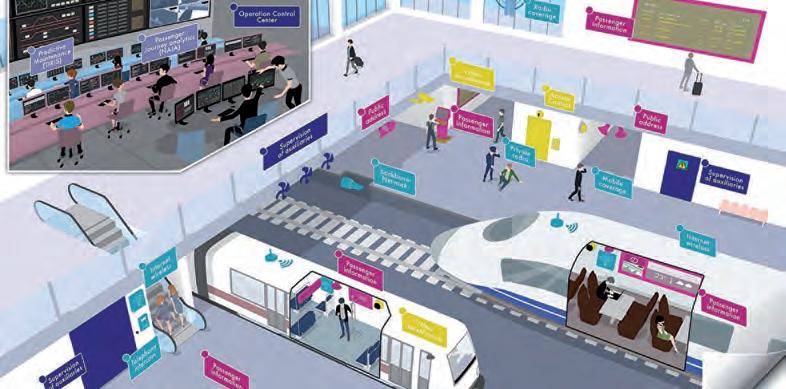
3 minute read
Meeting the challenge of multiple interfaces
Signalling Solutions
Working with multiple interfaces for maximum outcome
Global technology leader Thales is involved with numerous rail projects in Australia. Understandably, there are many factors to consider when aiming for a successful outcome.
In Australia, the Thales name is everywhere. Sydney Metro, Sydney Trains and Parramatta Light Rail are some key projects within the transportation sector.
Thales works with a multitude of external contractors and agencies to achieve its goals. This requires a systematic and organised approach to ensure all participants work from a common page.
The person tasked with ensuring this is Julien Terrochaire, Ground Transportation Systems Engineering Manager for Thales Australia.
Terrochaire, with about 14 years of experience in the metro industry, specialises in Signalling and Integrated Communication and Supervision (ICS).
“In mega transportation projects, the challenges are diverse and lay demand on all parts/functions of an organisation – engineering, procurement, project management, documentation, legal and finance,” Terrochaire told Rail Express.
“The challenge is to successfully deliver systems on complex projects that have multiple external interfaces to other systems which are not necessarily aligned in terms of schedule and requirements.”
As an example, Terrochaire put forward the Thales signalling CCS (Central Control System, also named as SCADA) and communication systems used in both greenfield and brownfield environments.
“Thales has significant, diverse experiences in this domain as a provider of integrated turnkey mission critical systems for rail,” he said.
The systems comprise signalling, communications and supervision, and are used all over the world. But for the purpose of discussion, Terrochaire focussed on a project closer to home - the ongoing extension of the Sydney Metro with the City (greenfield) and South West (brownfield) sections. “Thales systems are installed in every area of the metro, from the Operations Control Centre to the stations, the tracks and corridors. Thales is one of the few companies that can lay claim to this within the Sydney Metro project,” he said.
“On a daily basis, Thales co-ordinates between 19 external interfaces and 17 external contractors – each focussed on different aspects of the project. It takes tremendous flexibility and adaptation skills to operate successfully in such a complex, dynamic environment.”
Dealing with multiple contractors, almost naturally, means dealing with multiple new interfaces. Every new interface must be uniquely
An illustration of various interfaces Thales works with.
defined and managed (even if this new interface is from the same contractor).
Terrochaire emphasises this means that the same type of interface is redefined at least 17 times (sometimes even more) because one external contractor can own a specific interface for multiple locations and Thales must deal with a different person or entity within this contractor company.
• Challenge 1 - Schedule misalignment Terrochaire cites technical debt as the most unfortunate consequence of not doing it right in the first instance, due to misalignment of schedules of different contractors, the tendency to base design on assumptions and not signing off as per design review processes.
“The technical debt generates a series of events that results in a challenging relationship between all parties – mismatched priorities, frustrations for the contractors, additional pressure on the engineering and design teams, and pressure on the scheduling team to constantly rework, update and baseline the delivery program,” he said. • Challenge 2 - Design consistency Maintaining system design consistency and compliance across all interfacing parties is key and critical to ease the process.
While small adaptations may seem legitimate to undertake, in reality, it is almost impossible given the number of factors involved. • Challenge 3 - Overhead management Multiple coordination meetings, tools to exchange information, efforts to avoid technical debt, implementation and facilitating adequate stakeholder engagement add up quickly. Overhead management becomes critical.
“It takes tremendous resilience from the configuration officers and a strong commercial effort to keep across the numerous revisions in documentation, changes and variations which, if unresolved, lead to commercial disputes and tension between the various stakeholders,” Terrochaire said.
THE SECRET TO SUCCESS
How then does Thales consistently achieve project success and excellence in such a complex and dynamically evolving environment?
Terrochaire will reveal all in a presentation at the forthcoming AusRAIL PLUS conference.
“I am honoured to be speaking on Thales’ extraordinary ability to deliver quality outcomes in complex projects,” Terrochaire said. “I look forward to presenting an in-depth look into the challenges Thales faces and the various solutions we employ to minimise disruption, resolve these challenges and manage all the external factors implicated in this multi-layered environment.”
AusRAIL PLUS will be held at the ICC Sydney, from 28 February to 2 March, 2022.










